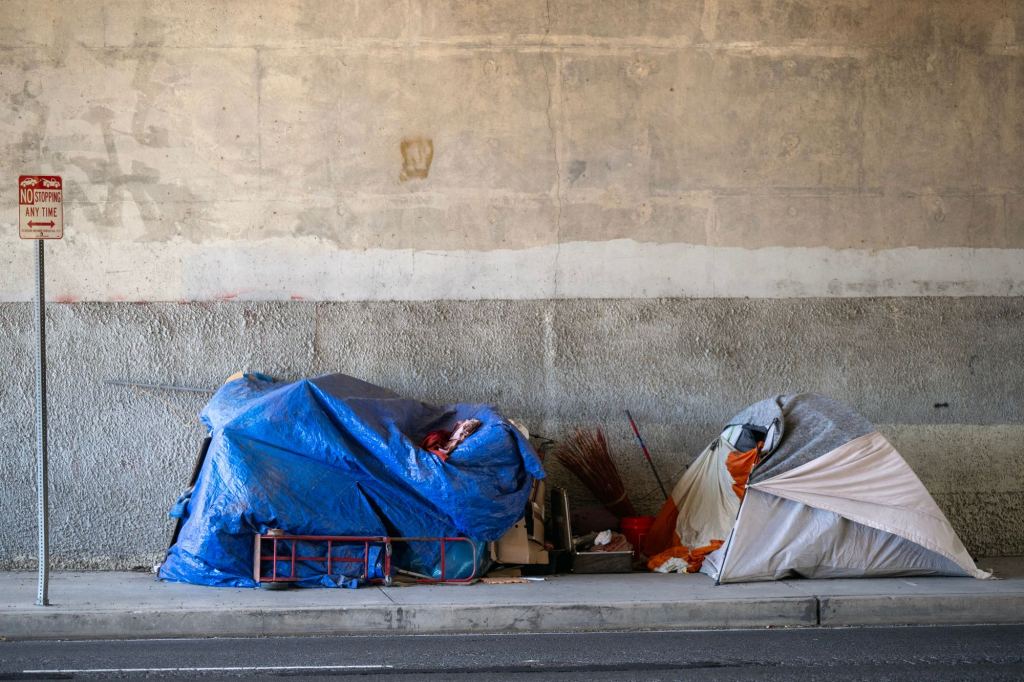A homeless tent stands under the 101 Freeway on Hayvenhurst Boulevard in Encino on Tuesday, May 7, 2024. (Photo by Hans Gutknecht, Los Angeles Daily News/SCNG)
California, and especially Los Angeles County, has failed on every level in addressing homelessness, and the government doesn’t even know where its money is going.
In March, the city of Los Angeles was ordered by a federal judge to pay for an audit of all homelessness-fighting expenditures and programs the city has funded or operated since the beginning of 2020.
In April, the state auditor reported that no one knows where or how effectively California has spent the “significant additional dollars” it has put into state-funded homelessness assistance programs since 2021.
In May, the Los Angeles County Board of Supervisors heard the CEO of the Los Angeles Homeless Services Authority read a PowerPoint presentation outlining how LAHSA distributes the $848 million in annual funding it collects from federal, state, county and city taxpayers, as well as $2 million from philanthropic sources.
LAHSA is a joint city-county powers agency that exists as a pass-through organization to distribute funds from “funders” to “providers” – more than 100 nonprofit “partner agencies” that make all hiring and contracting decisions to deliver homeless services.
At their May 21 board meeting, Los Angeles County Supervisors were briefed by leaders of provider organizations, the CEO of LAHSA, and county officials on the problem at hand: providers are having to take out lines of credit to pay millions of dollars in monthly bills while they wait for missing payments from LAHSA.
Everyone agrees that the payment system is broken, and you probably won’t be surprised to hear that everyone’s favorite solution is to somehow get paid more and faster. The supervisors have asked for a report on various options for making that happen. Later this month, they’ll hear another PowerPoint presentation.
Currently, service providers pay their employees, contractors and expenses, then send an invoice to LAHSA to get reimbursed. LAHSA then sends an invoice to each government. When the money comes in, LAHSA pays the provider. At that point, the provider is still accruing interest because they’re borrowing money to pay for another month’s worth of service, and the county doesn’t pay it back.
The county has been prepaying LAHSA’s “working capital” to avoid late payments, but apparently that hasn’t worked.
The truth is, this system wasn’t designed to work at all – it was designed to spread responsibility so widely that it fell off the edge of the spreadsheet and no one was held accountable for the results.
The size of the service delivery system and accountability issues expanded exponentially with the 2017 passage of Measure H, which temporarily increased sales taxes by 0.25% in Los Angeles County to cover the costs of homeless services. The system and issues expanded again with the influx of COVID relief funds.
COVID-19 funding is running out and Measure H expires in 2027. Supervisor Hilda Solis pointed out the elephant in the room: “We’re going to be faced with a situation where we have to go back to our constituents very soon,” she said.
She probably shouldn’t have said that. The measure heading for the November ballot, which would double Measure H’s sales tax and make it permanent, is a “citizen initiative.” It allows it to pass through the state Supreme Court’s “Upland” loophole, which was created after the Supreme Court in a 2017 case suggested the Constitution doesn’t apply to “citizen initiative” tax increases, and would require just a 50% plus 1 vote to pass, rather than the two-thirds majority required by the Constitution.
If Solis and his fellow council members were to put the tax measure on the ballot as “we,” they would need a two-thirds majority.
Either way, voters should just say “no” and let counties answer the tough questions: Should government provide homeless services directly? Should health, behavioral and housing services be delivered differently to get better results? Should the role of nonprofits and their highly paid executives be reduced or eliminated?
Those who spoke at the board described their work as a “mission,” but this mission comes with very mundane benefits. According to tax returns, the top executives at these service providers had salaries ranging from $200,000 to $350,000 in 2022. LAHSA’s CEO was hired in January 2023 for $430,000 per year.
This is an insane system that isn’t working, and it’s time to scrap it and start over.
Email her at [email protected] or follow her on Twitter @Susan_Shelley.

